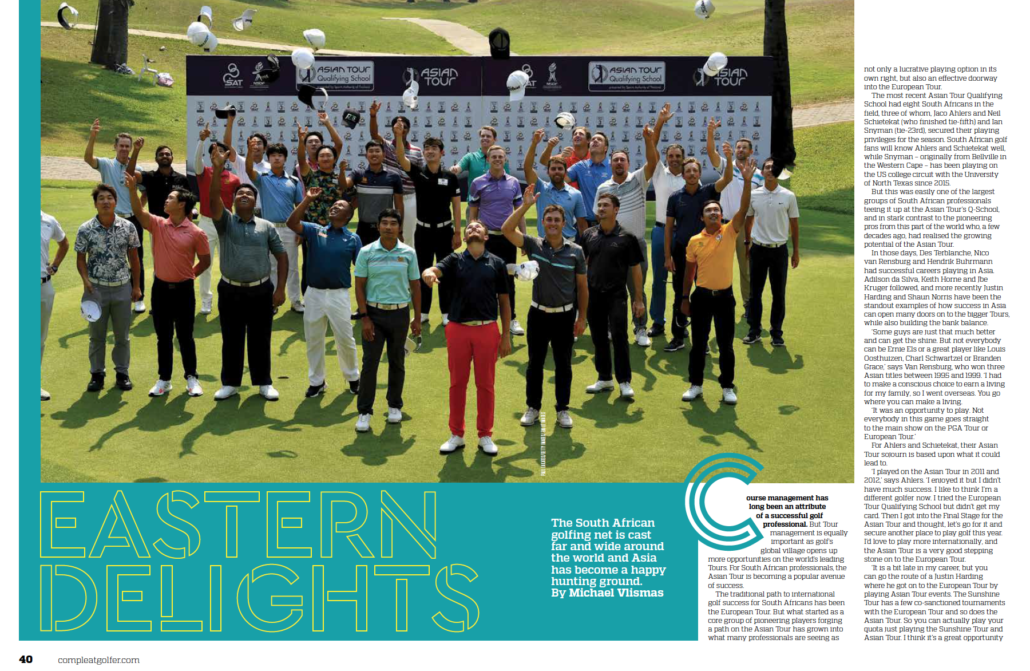The South African golfing net is cast far and wide around the world and Asia has become a happy hunting ground, writes MICHAEL VLISMAS.
Course management has long been an attribute of a successful golf professional. But Tour management is equally important as golf’s global village opens up more opportunities on the world’s leading Tours.
For South African professionals, the Asian Tour is becoming a popular avenue of success. The traditional path to international golf success for South Africans has been the European Tour. But what started as a core group of pioneering players forging a path on the Asian Tour has grown into what many professionals are seeing as not only a lucrative playing option in its own right, but also an effective doorway into the European Tour.
The most recent Asian Tour Qualifying School had eight South Africans in the field, three of whom, Jaco Ahlers and Neil Schietekat (who finished tie-fifth) and Ian Snyman (tie-23rd), secured their playing privileges for the season. South African golf fans will know Ahlers and Schietekat well, while Snyman – originally from Bellville in the Western Cape – has been playing on the US college circuit with the University of North Texas since 2015.
But this was easily one of the largest groups of South African professionals teeing it up at the Asian Tour’s Q-School , and in stark contrast to the pioneering pros from this part of the world who, a few decades ago, had realised the growing potential of the Asian Tour.
In those days, Des Terblanche, Nico van Rensburg and Hendrik Buhrmann had successful careers playing in Asia. Adilson da Silva, Keith Horne and Jbe Kruger followed, and more recently Justin Harding and Shaun Norris have been the standout examples of how success in Asia can open many doors on to the bigger Tours, while also building the bank balance.
‘Some guys are just that much better and can get the shine. But not everybody can be Ernie Els or a great player like Louis Oosthuizen, Charl Schwartzel or Branden Grace,’ says Van Rensburg, who won three Asian titles between 1995 and 1999. ‘I had to make a conscious choice to earn a living for my family, so I went overseas. You go where you can make a living.
‘It was an opportunity to play. Not everybody in this game goes straight to the main show on the PGA Tour or European Tour.’
For Ahlers and Schietekat, their Asian Tour sojourn is based upon what it could lead to. ‘I played on the Asian Tour in 2011 and 2012,’ says Ahlers.
‘I enjoyed it but I didn’t have much success. I like to think I’m a different golfer now. I tried the European Tour Qualifying School but didn’t get my card. Then I got into the Final Stage for the Asian Tour and thought, let’s go for it and secure another place to play golf this year. I’d love to play more internationally, and the Asian Tour is a very good stepping stone on to the European Tour.
‘It is a bit late in my career, but you can go the route of a Justin Harding where he got on to the European Tour by playing Asian Tour events. The Sunshine Tour has a few co-sanctioned tournaments with the European Tour and so does the Asian Tour. So you can actually play your quota just playing the Sunshine Tour and Asian Tour. I think it’s a great opportunity to play a different Tour and find another route into Europe.
‘I don’t want to take anything away from the Asian Tour, but there’s a greater opportunity to secure your card there than on the European Tour. The European Tour’s Q-School lasts six days and they issue only 25 cards. The Asian Tour’s is five days with 35 cards. And keeping your card on the Asian Tour is easier than on the European Tour. You don’t have to make as much money. The Asian Tour also has categories on the European Tour, so if you are high up on the moneylist, you’ll get into a few European Tour events. There are a few ways of getting on to bigger Tours via the Asian Tour.’
Schietekat secured his card in a more unlikely way. After a frustrating season his game and the extended periods away from his wife and two-year-old child, he decided to reassess.
‘I was entered for the Japan Golf Tour Qualifying School, but I pulled out at the last minute as I felt my game wasn’t where it should be. I wasn’t happy with my game for pretty much the whole of 2019. And I struggled with being away from home for so long. My wife suggested I take a breather for a while and then enter the Asian Tour Qualifying School. So I did, and got my card.’
As a proven winner on the Sunshine Tour, Schietekat feels the Asian Tour offers him the opportunity to take his game to the next level.
‘The golf is definitely a step up and it can only make me better. Between the Sunshine Tour and Asian Tour I have a full schedule now. As a professional, the last thing you want to do is sit around. You want to play as much as you can while you can.’ South Africans seem particularly suited to golf in Asia.
‘We all know we can play everywhere in the world. The Sunshine Tour is really strong so we can all play at the level required for other Tours. On the Sunshine Tour we’re used to playing in different conditions. It’s the same on the Asian Tour. I think it’s easier for a South African to acclimatise on the Asian Tour than it is for a European,’ says Ahlers.
Schietekat agrees.
‘Climate-wise, it’s familiar for South Africans. It’s hot and humid, and South Africans love that. We don’t enjoy the cold of Europe so much. The course conditions are also similar to our KwaZulu-Natal golf courses – grainy greens but still in really good condition.
The courses certainly aren’t walkovers. They’re a good grind, and we also like that. As a Sunshine Tour player you’re exposed to a lot of tough weeks with wind and difficult greens, so it’s not as much of an adjustment when you come over to Asia.’
Ahlers and Schietekat believe the number of South Africans making their way to Asia will grow.
‘We were eight Southern Africans at the Asian Tour Qualifying School, so there’s certainly a growing interest in the Asian Tour. It’s a nice place to be. It can be unbearably hot. But the food is good and the people are very friendly. They don’t mind outsiders, which you don’t always feel in Europe. And it’s not that expensive. It’s a lot less expensive than Europe.
‘The heat can be a negative and you need to get used to a different type of grass, which brings with it a different way of playing golf. If you play a lot overseas, though, you can get used to it. It’s not that difficult to adjust to. It’s just a different way of thinking. There’s not as much bent grass as we get at home. You also need to be heat-tolerant, though, because it gets really hot, especially in Malaysia and Indonesia.’
The welcoming nature of Asia certainly impresses Schietekat.
‘The food is unique. The people are very welcoming and they always have a smile on their faces. That includes the Asian Tour staff. They just want to help you. It’s incredible how they make you feel so at home. That helps somebody like me when you’re missing home.’
Clearly, the language barrier is not a hindrance for the South Africans because the Asian Tour spells opportunity in a manner they are all starting to understand.
LEADING SOUTH AFRICAN ON THE ASIAN TOUR ORDER OF MERIT
1998 Nico van Rensburg (4th)
1999 James Kingston (5th)
2000 Craig Kamps (4th)
2001 James Kingston (7th)
2002 James Kingston (16th)
2003 James Kingston (23rd)
2004 Chris Williams (30th)
2005 James Kingston (8th)
2006 Hendrik Buhrmann (39th)
2007 Anton Haig (3rd)
2008 Keith Horne (57th)
2009 Keith Horne (25th)
2010 Keith Horne (14th)
2011 Jbe Kruger (4th)
2012 Jbe Kruger (4th)
2013 Jbe Kruger (41st)
2014 Jbe Kruger (33rd)
2015 Shaun Norris (22nd)
2016 Shaun Norris (19th)
2017 Keith Horne (29th)
2018 Justin Harding (3rd)
2019 Jbe Kruger (6th)







